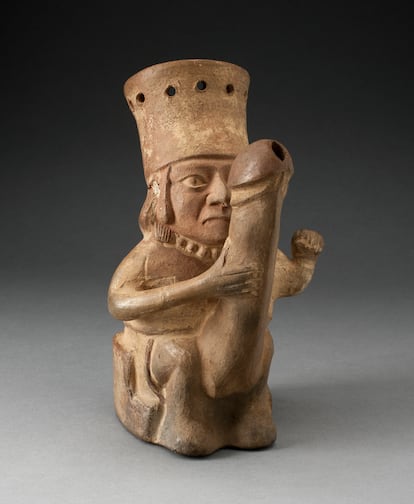‘Small dick energy’: Why we shouldn’t continue to mock penis size
Greta Thunberg’s response to Andrew Tate, the misogynistic influencer who taunted her, has been applauded on social media, but it perpetuates an old myth linking male character to genital endowment


One fine morning, Andrew Tate, the British-American former wrestler, toxic masculinity influencer and climate change denier, woke up spoiling for a fight. He searched social media for a scapegoat against whom to vent his anger and decided on Swedish environmental activist Greta Thunberg. Tate assumed that the Swedish activist would be easy prey for his sarcasm. He tried to provoke her with a now-infamous tweet: “Please provide your email address so I can send a complete list of my car collection and their respective enormous emissions.” The 19-year-old Thunberg fired back a memorable retort: “Yes, please do enlighten me. Email me at smalldickenergy@getalife.com...”
yes, please do enlighten me. email me at smalldickenergy@getalife.com https://t.co/V8geeVvEvg
— Greta Thunberg (@GretaThunberg) December 28, 2022
Was that a technical knockout? Judging by the reaction of most internet users, certainly. On this occasion, Tate had not bragged about the size of his penis. But he had mentioned his cars, which, as psychologist and humorist Flavia dos Santos points out, “amounts to the same thing.” Big, powerful, flashy cars are often considered attributes of masculinity, akin to the feathers with which peacocks try to overwhelm their potential mates in bird courtship rituals. In her cutting reply, Thunberg went for the jugular; she was commenting on the phenomenon of overcompensation, that is, the tendency on the part of those who harbor deep insecurities to brag about the horsepower of their car (or money, or lack of sensitivity and scruples).
Some have so much, others so little
Tate reacted badly to the jab and went into a frenzy, thereby increasing his embarrassment. He might have tried being dignified and reproaching Thunberg for settling a dispute by bringing up her interlocutor’s (allegedly) small penis. Then again, it wouldn’t have worked: social media is all too familiar with rapper Latto’s song Big Energy, the refrain of which features the phrase “big dick energy,” meaning an attempt to heal the scars of wounded masculinity. Everyone knew exactly what Greta was talking about.
Beyond the Thunberg-Tate exchange, it is clear that the stigma around small penises is still alive and well in some quarters. Some men are still mortified by the suspicion (or the knowledge) of their member’s below-average dimensions.
The subject has been studied in depth. In 2014, Christopher Morriss-Roberts, a podiatrist and professor of sports sociology, conducted a field study and found that British athletes (irrespective of their sexual proclivities) cast sideways glances at their locker room mate’s penis to compare it with their own. Morriss-Roberts also concluded that, in the “cockocracy” that he believes still reigns supreme in sports locker rooms, a small penis is associated with excess body fat, a lack of stamina and ambition and even unhealthy lifestyle habits. In addition, the podiatrist also seized the opportunity to debunk the popular urban legend that links the size of a man’s feet to the size of his penis; there is no correlation of any kind between the two.
Tell me how long it is, and I’ll tell you how much you’re worth
One study does claim that there’s a correlation between penis size and salary, though it’s not the association you might think. The study says that American men with small penises get paid a lot more. According to data from the online bazaar OnlyBuy and published somewhat uncritically by the New York Post and The Sun, those with penises that measure 7-8 centimeters (2.76 inches-3.15 inches; micropenis territory) earn an average of $76,000 per year, while those who exceed 17 centimeters (6.69 inches) earn $50,300.

The aforementioned claim is most likely one of the many “absurd or spurious” correlations that social scientist Carl Bergstrom denounces in his book Calling Bullshit: The Art of Skepticism in a Data-Driven World. Further, as journalist Ben Cost points out, there’s a more sensible and mundane potential explanation for the penis-size salary gap: “Men who earn less money tend to brag more about the size of their penis.” Or perhaps the opposite is true: those who assume their penis is small tend to brag more about the money they earn.
By now, you may be asking yourself a disturbing question: what do we mean by small penis? There’s not a simple answer to that question. As journalist Clár McWeeney reminds us, “large and small are deliberately vague categories, born from the imperfect crossover between biological realities and social expectations.” Put differently, before deciding that a penis is too small, “we should ask ourselves what the organ is meant to do and the minimum dimensions it needs in order to perform its function.” A “functional” penis is one that can be used to urinate without any problem; one that serves for sexual intercourse is sexually functional, regardless of size.
In 2022, the worldwide average length of an erect penis was 13.58 centimeters (5.35 inches). However, there were significant geographical variations in size, from Ecuador’s average of 17.61 centimeters (6.93 inches) to Cambodia’s 10.4 centimeters (4.09 inches). In the middle, Spain averages 13.85 centimeters (5.45 inches), Italy 15.35 centimeters (6.04 inches), and France 15.74 centimeters (6.2 inches). Yet the pornography, erotic literature and mainstream film industries have given us a very different impression.
(Almost) any penis will do
Sexologist Eva Moreno emphasizes that unrealistic porn images have created anxiety around penis size. “Penises 20 centimeters [7.87 inches] in size or longer may be common in porn, but in everyday life they are very rare.” Furthermore, “the extent to which they are fully functional [remains to be seen], since they can create discomfort and, in some cases, make sexual intercourse difficult and painful or less pleasurable.”

Nevertheless, Moreno says that both above-average-sized and small penises can be used “reasonably and satisfactorily…Size does not matter, or it matters very little.” But a significant number of men “continue to suffer the ravages of inadequate psychosexual and affective education – which is provided by the heteropatriarchy – and feel frustrated, dysfunctional and incomplete if they do not live up to the toxic fantasy of huge penises that porn sells us.”
She encounters this sentiment on a daily basis, both in her practice and at the erotic store she owns: “Most [men] who suffer from that small-penis stigma ask me for effective methods to satisfy their fantasy of powerful masculinity. And my job is to tell them that there aren’t any. Yes, they could take an Andean maca pill, which increases muscular irrigation, or Viagra to promote and maintain an erection. And in extreme cases, they could resort to an invasive surgery and put on a prosthesis. But the sad truth, or good news, depending on how you look at it, is that they don’t need it; the emotional baggage associated with unrealistic expectations and an unfair stigma keeps them from accepting themselves as they are and, in many cases, causes their sexual performance problems, like erectile dysfunction.”
Moreno notes that penis problems are rarer than men think: “There is nothing wrong with the vast majority of penises. Even a micropenis can be perfectly functional in the context of a richer, more varied sex life, one that focuses less on intercourse and more on communication, play and empathy.” After all, “if two women can give each other pleasure, why can’t a man satisfy his partners, regardless of his penis size?”
Pleasure, coming and going
Moreno encourages men, especially young men, “to stop perpetuating stereotypes and instead look at open, honest and untraumatized sexuality, as many women are already doing.” The challenge is to “overcome, once and for all, the emotional baggage caused by high school group masturbation, sidelong glances at the size of your neighbor’s penis in the bathroom or showers, the emotionally immature first partner who created traumas and insecurities because, perhaps unintentionally, you were burdened with the responsibility of satisfying her.”
She also recommends “keeping porn in perspective and]understanding… what it is and what it is intended for… it’s a fantasy.” Porn is not a vehicle for sex education, but we have turned it into one with “our inability to introduce healthy, sensible and realistic sexuality content into the educational curriculum.” In the same way that superstition proliferates in the absence of science, “sexual obscurantism grows in the vacuum that we adults create by not finding the right way to educate children, adolescents and young people about sex, according to their level of maturity and development.”
Sexologist Elena Requena agrees that, as a society, “we continue to associate masculinity and power with penis size.” That’s because of cultural stereotypes about sexual potency and reproductive capacity, which stem from specific historical circumstances: “In ancient cultures, like classical Greece, small penises were considered more harmonious and associated with the ideals of beauty and wisdom.” That idea was later recovered by Renaissance art, but it’s a far cry from our contemporary phallocentric logic.
Extremely toxic topics
Of the men Requena counsels who have doubts about the adequacy of their penises, “most have perfectly average dimensions, but they are still convinced that they don’t measure up.” Social prejudices fuel that distorted vision, as does “the type of pornography they consume.” Without “inclusive, quality sex education, erotic encounters between individuals continue to be weighed down by false expectations.”
Requena emphasizes that “we must disabuse ourselves once and for all of the notion that the bigger the penis, the more masculine or the better the lover, because that’s not the case at all.” The sexologist is reluctant to discuss the thorny issue of normal penis size; in her opinion, it doesn’t matter. “All penises can provide pleasure, as long as we find our sexual partners desirable.”
Moreover, “anatomically, in the case of vaginal penetration, the initial third (i.e., the first 5 or 6 centimeters [1.97 or 2.36 inches] of the penis) is sensitive and therefore provides pleasure in sexual intercourse.” The rest is simply a matter of individual preference: “There will be people who find a certain-sized penis more attractive, but that varies a lot.”
According to Requena, in order to allow ourselves the luxury of enjoying an unprejudiced sexuality free of traumatic emotional baggage, we must ignore “counterproductive and dangerous messages,” such as mainstream porn’s “fixation on large penises.” But the problem is not so much the porn itself but rather “the lack of reliable information that dispels misconceptions.” Sex education should be “the foundation on which we [base our ideas about sex] so that no man is traumatized by the size of his penis.” Not even the ones who compensate for possible shortcomings by boasting about how much their cars pollute the environment. According to the sexologist, even Tate deserves to “feel desirable and regard himself in a kinder way.”
Sign up for our weekly newsletter to get more English-language news coverage from EL PAÍS USA Edition
Tu suscripción se está usando en otro dispositivo
¿Quieres añadir otro usuario a tu suscripción?
Si continúas leyendo en este dispositivo, no se podrá leer en el otro.
FlechaTu suscripción se está usando en otro dispositivo y solo puedes acceder a EL PAÍS desde un dispositivo a la vez.
Si quieres compartir tu cuenta, cambia tu suscripción a la modalidad Premium, así podrás añadir otro usuario. Cada uno accederá con su propia cuenta de email, lo que os permitirá personalizar vuestra experiencia en EL PAÍS.
¿Tienes una suscripción de empresa? Accede aquí para contratar más cuentas.
En el caso de no saber quién está usando tu cuenta, te recomendamos cambiar tu contraseña aquí.
Si decides continuar compartiendo tu cuenta, este mensaje se mostrará en tu dispositivo y en el de la otra persona que está usando tu cuenta de forma indefinida, afectando a tu experiencia de lectura. Puedes consultar aquí los términos y condiciones de la suscripción digital.










































